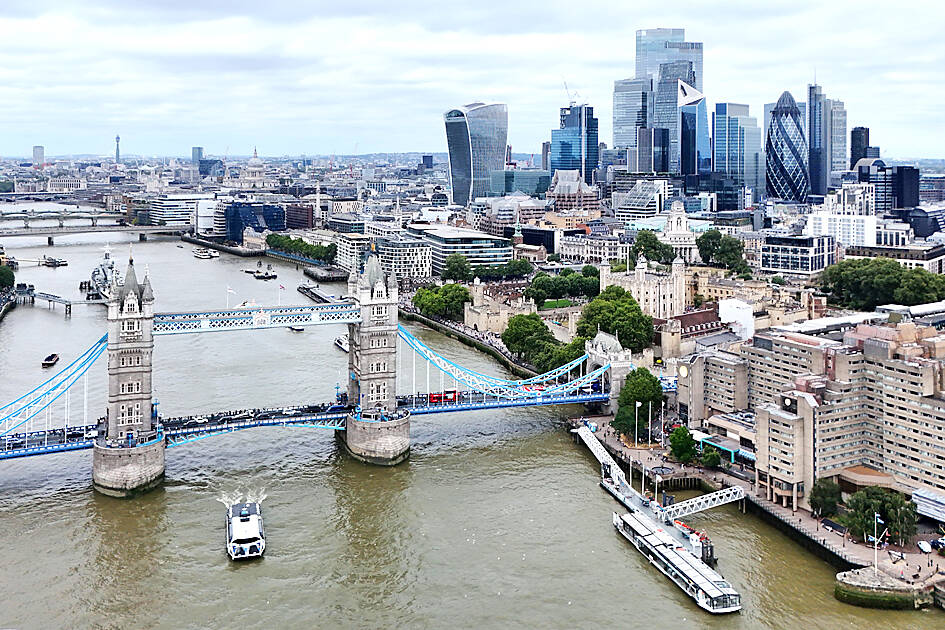The UK yesterday launched its first formal industrial strategy in seven years, as the new Labour Party government pledged greater stability and certainty for businesses on the eve of a major investment summit in London.
The UK’s manufacturers have been calling for a new strategy for the industrial sector from the government, which they say would give them certainty over long-term policy direction in a post-Brexit, post-pandemic world that has undergone energy shocks and high inflation.
Make UK, the sector’s trade body, has said the UK is the only major economy not to have a comprehensive industrial plan in place.

Photo: EPA-EFE
The UK last published an industrial strategy under then-prime minister Theresa May’s government in 2017.
Details of the new industrial strategy would be laid out in a consultation document, known as a green paper, to be published this morning local time.
The government said it would focus on eight growth sectors: Advanced manufacturing, clean energy, creative industries, defense, digital and technologies, financial services, life sciences and professional and business services.
“Our modern Industrial Strategy will hard-wire stability for investors and give them the confidence to plan not just for the next year, but for the next 10 years and beyond,” UK Secretary of State for Business and Trade Jonathan Reynolds said in a statement.
The government also named Microsoft UK chief executive officer Clare Barclay as chair of its new Industrial Strategy Advisory Council.
The launch of the strategy coincides with today’s UK’s investment summit, which the UK government said would bring together up to 300 industry leaders.
It also comes after British Prime Minister Keir Starmer’s Labour Party marked 100 days in power on Saturday, a rocky period marked by a controversy over politicians accepting freebies and the resignation of Starmer’s chief of staff Sue Gray.

When an apartment comes up for rent in Germany’s big cities, hundreds of prospective tenants often queue down the street to view it, but the acute shortage of affordable housing is getting scant attention ahead of today’s snap general election. “Housing is one of the main problems for people, but nobody talks about it, nobody takes it seriously,” said Andreas Ibel, president of Build Europe, an association representing housing developers. Migration and the sluggish economy top the list of voters’ concerns, but analysts say housing policy fails to break through as returns on investment take time to register, making the

NOT TO WORRY: Some people are concerned funds might continue moving out of the country, but the central bank said financial account outflows are not unusual in Taiwan Taiwan’s outbound investments hit a new high last year due to investments made by contract chipmaker Taiwan Semiconductor Manufacturing Co (TSMC, 台積電) and other major manufacturers to boost global expansion, the central bank said on Thursday. The net increase in outbound investments last year reached a record US$21.05 billion, while the net increase in outbound investments by Taiwanese residents reached a record US$31.98 billion, central bank data showed. Chen Fei-wen (陳斐紋), deputy director of the central bank’s Department of Economic Research, said the increase was largely due to TSMC’s efforts to expand production in the US and Japan. Investments by Vanguard International

WARNING SHOT: The US president has threatened to impose 25 percent tariffs on all imported vehicles, and similar or higher duties on pharmaceuticals and semiconductors US President Donald Trump on Wednesday suggested that a trade deal with China was “possible” — a key target in the US leader’s tariffs policy. The US in 2020 had already agreed to “a great trade deal with China” and a new deal was “possible,” Trump said. Trump said he expected Chinese President Xi Jinping (習近平) to visit the US, without giving a timeline for his trip. Trump also said that he was talking to China about TikTok, as the US seeks to broker a sale of the popular app owned by Chinese firm ByteDance Ltd (字節跳動). Trump last week said that he had

STRUGGLING TO SURVIVE: The group is proposing a consortium of investors, with Tesla as the largest backer, and possibly a minority investment by Hon Hai Precision Nissan Motor Co shares jumped after the Financial Times reported that a high-level Japanese group has drawn up plans to seek investment from Elon Musk’s Tesla Inc to aid the struggling automaker. The group believes the electric vehicle (EV) maker is interested in acquiring Nissan’s plants in the US, the newspaper reported, citing people it did not identify. The proposal envisions a consortium of investors, with Tesla as the largest backer, but also includes the possibility of a minority investment by Hon Hai Precision Industry Co (鴻海精密) to prevent a full takeover by the Apple supplier, the report said. The group is